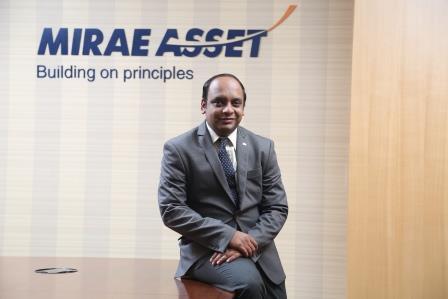 Harshad Borawake, Head of Research – Equity, Mirae Mutual Fund has over 12 years of research experience across industries which include Financials, Oil and Gas and Economy. He currently co-manages the Mirae Asset India Equity Fund, the flagship fund and largest by AUM in the AMC, along with Neelesh Surana, CIO of the AMC. Harshad has a Bachelor of Engineering degree and is also an MBA in Finance. He speaks to Geojit Insights on the current market scenario and the funds he manages.
Harshad Borawake, Head of Research – Equity, Mirae Mutual Fund has over 12 years of research experience across industries which include Financials, Oil and Gas and Economy. He currently co-manages the Mirae Asset India Equity Fund, the flagship fund and largest by AUM in the AMC, along with Neelesh Surana, CIO of the AMC. Harshad has a Bachelor of Engineering degree and is also an MBA in Finance. He speaks to Geojit Insights on the current market scenario and the funds he manages.
What are the favourable factors, you think will help the Indian market to rebound or counter the global headwinds in near future?
Over the long term markets track corporate earnings and after some policy led disruption in 2017, Indian corporate earnings are now normalizing rapidly.
We expect earnings momentum to sustain led by few factors like decent monsoon for a continuous period of three years coupled with increased Government spends on Infra and other social sectors (esp. in a pre-election year). This should have a favourable impact on consumer sentiments and demand. High frequency data points indicate positive demand momentum in quite a few categories. Over the medium term we expect revival in the private CAPEX as the industry utilization increases. We believe the resilient nature of consumer demand and likely revival in the private CAPEX can act as a counter force to the global headwinds.
Not only inflation but other factors like CAD target pressure, higher expenditure expectations and uncertainty on several revenue streams are posing challenges in domestic front. What portfolio strategies have you adopted to manage this situation?
While we do take cognizance of the macro data points, our style of investment is primarily bottom up approach. We analyse individual companies, understand various drivers to its revenue streams, profitability and compute the price value gap to reach to our investment decision. In the current situation of macro headwinds (or otherwise also), we continuously monitor our investments and if required, modify our portfolios or recalibrate our weights in order to deliver better risk adjusted returns.
Pharma and health care have given promising returns in selected pockets. Do you foresee a similar growth in the coming days? What are the challenges in this space?
The Pharma sector which was mainly impacted by regulatory and pricing issues in the US, seems to have stabilized as per the commentary of both Indian and global generic players. The base business (existing US business) for most of the Indian companies has been cut to size substantially and we believe that it is unlikely to shrink further.
We expect earnings to start seeing an uptick from FY20 in most of the pharma companies as their investment into specialty and complex generics will start yielding results over the next 3-5 years in the US. Further, growth will also come from increased contribution of branded generic business in India and Emerging markets.
Now credit off take has improved since January 2018 and is still showing good traction. What is your call on private sector banks and NBFCs in this regard? Your portfolio shows an increasing appetite for financial services.
Indian Banks continue to benefit from structural drivers like underlying economic growth, increasing penetration and new financial product offerings. As you rightly said, the credit off take has improved in the recent period, it is more driven by the consumer credit in the last few quarters and corporate credit has just started to show some uptick.
Within the banking space, we like private banks and also have some allocation towards corporate banks. We believe the private banks within our portfolio have ability to compound given their focus on retail, market share gains and have good asset quality. On the corporate banks, we believe the worst is behind with recognition and provisioning for NPA largely done and expect earnings as well as valuation to normalize soon.
Funds are finding it difficult to outperform their benchmark after the implementation of TRI. Does this imply that the expenses on active fund management will affect the fund performance or any other factor?
Correlating the recent underperformance of various funds with the implementation of TRI may not be a very good idea. Performance of any scheme should be compared over the long periods to reach to any rational conclusion. In the recent times, select few stocks have contributed disproportionately to the indices upward movement. Hence, large cap and diversified funds have been negatively impacted.
The fund you manage holds more than 60 stocks in its portfolio but the stock concentration on particular stocks are comparatively low. Is this a part of any investment strategy which you follow? Will it affect alpha generation?
We manage diversified fund and try to minimise stock specific risk to the portfolio. We try to outperform the benchmark with better stock selection and having appropriate weights in the portfolio.
What parameters do you consider in stock picking? What are the out of the box factors you analyse while making a tactical allocation?
We follow a bottom up approach in stock selection and our investment philosophy is centred on participating in high quality businesses, run by competent management and hold them for an extended period. Some of the factors which we look in any company are its business opportunity size, profitability and capital efficiency, among others. As long as the assessed value is more than price, also known as margin of safety, the stock can be considered for the portfolio.
All the major indices are touching new highs and Nifty 50 PE is trading at a multiple of 28. What is your investment strategy at this time? And what is your advice to the investors?
As I said, we have a bottom up approach and in that context the index PE has little significance for a portfolio. We believe that the long term India story is intact and we will see meaningful wealth creation opportunities in the coming years. I would advise that investors should frame their asset allocation strategy (based on individual risk profile) and equity investment should be made in a staggered manner to ride through the volatile nature of this asset class.
Government is trying hard to propel infrastructure growth in India through projects like Bharatmala and Sagarmala. Is it right time to augment allocation in infra fund?
We do not have any infra fund offerings, and would not like to comment. However we believe diversified funds which have flexibility to move across market caps and sectors, can outperform most thematic funds across time frames.
Investors generally shy away from markets during a fall and they even redeem investments. In such a situation, what difficulties do you face as a fund manager?
Sadly, that is the hard truth in behavioural finance. However, we believe that the Indian investor is becoming financially savvy and is incrementally showing maturity. We see in this correction, SIP flows have remained intact, however lump sum flows have moderated. To mitigate the risk from such unforeseen circumstances, we keep a close watch on the liquidity of the overall portfolio.










